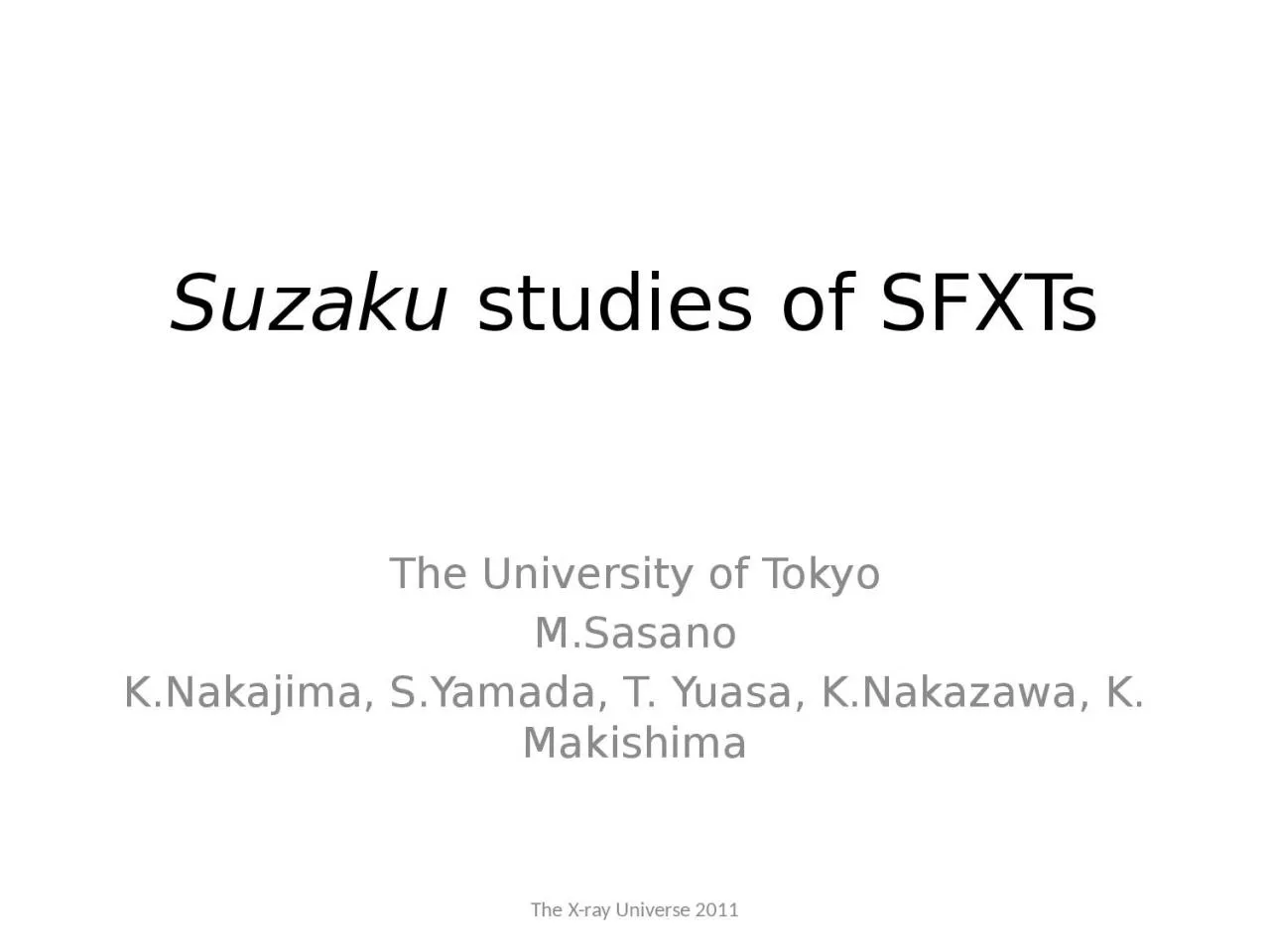

The Xray Universe 2011 The University of Tokyo MSasano KNakajima SYamada T Yuasa KNakazawa K Makishima 1 Introduction Power of Suzaku in SFXT studies Very drastic flares on ID: 1012723
Download Presentation The PPT/PDF document "Suzaku studies of SFXTs" is the property of its rightful owner. Permission is granted to download and print the materials on this web site for personal, non-commercial use only, and to display it on your personal computer provided you do not modify the materials and that you retain all copyright notices contained in the materials. By downloading content from our website, you accept the terms of this agreement.
1. Suzaku studies of SFXTsThe X-ray Universe 2011The University of TokyoM.SasanoK.Nakajima, S.Yamada, T. Yuasa, K.Nakazawa, K. Makishima
2. 1. Introduction~Power of Suzaku in SFXT studies~Very drastic flares on short time scales (〜 a few hours), with flux increases by 2-3 orders of magnitude. Sometimes very slow pulsations.Highly absorbed hard spectra.The X-ray Universe 2011SFXTs (Super-giant Fast X-ray Transients), a new class of High Mass X-ray Binary, show -Suchy et al. (2011)1A1118-61Using Suzaku, we can study - Absorption Continuum Iron linesWide-band spectroscopy is essential in their studies.
3. 2. SFXTs observed with SuzakuSo far, Suzaku observed 6 SFXTs, and will observe 2 more. Data sets of 5 objects are publicly available.Two of the 5 objects exhibited flares typical of SFXTs.IGR J17544-2619 Rampy et al. (2009)The absorption fluctuated in the flare.Fe-K EW < 14.2 eV (quiescence),< ** eV (flare).AX J161929-4945 Morris et al.(2009)A high absorption (〜 1023 cm-2), with some changes in a flare.Fe-K EW < 300 eV (quiescence) ,< 50 eV (flare). The X-ray Universe 2011We perform detailed reanalysis of AX J161929-4945 focusing on the iron line.1Energy keV40count/s 40200100002060Time (hr)counts/s/keV χ
4. 3 .Light curves of AX J161929-4945The X-ray Universe 2011Time (ks)2040600count/seccount/secHardness150.51.00.51.01.5
5. 3 .Light curves of AX J161929-4945The X-ray Universe 2011Time (ks)2040600count/seccount/secHardness150.51.00.51.01.5A large flare was detected.
6. 3 .Light curves of AX J161929-4945The X-ray Universe 2011Time (ks)2040600count/seccount/secHardness150.51.00.51.01.5〜 30 times
7. 3 .Light curves of AX J161929-4945The X-ray Universe 2011Time (ks)2040600count/seccount/secHardness150.51.00.51.01.5Duration〜4 hr
8. 3 .Light curves of AX J161929-4945The X-ray Universe 2011Time (ks)2040600count/seccount/secHardness150.51.00.51.01.5Rise time〜1.4 hr
9. 3 .Light curves of AX J161929-4945The X-ray Universe 2011Time (ks)2040600count/seccount/secHardness150.51.00.51.01.5FlareQuiescence
10. The X-ray Universe 2011FlareQuiescence4. Spectral analysis4-1 Background-subtracted count spectraXISHXD
11. The X-ray Universe 20114-2. Ratio between flare and quiescenceEnergy (keV)Ratio40101.5110
12. The X-ray Universe 20114-2. Ratio between flare and quiescenceEnergy (keV)Ratio40101.5110From 1.5 keV to 40 keVSpectral shape did not change.Average NH remained nearly the same.
13. The X-ray Universe 20114-3. Focus on Iron line 5.57.5Energy (keV)QuiescenceFlare
14. The X-ray Universe 20114-3. Focus on Iron line The narrow iron line was detected in quiescence. 5.57.5Energy (keV)FlareQuiescence
15. The X-ray Universe 20114-3. Focus on Iron line However, in the flare, the narrow line almost disappeared.A broad one may be allowed.The narrow iron line was detected in quiescence. 5.57.5Energy (keV)QuiescenceFlare
16. The X-ray Universe 2011count/s/keV1e-41e-30.010.110-22Energy(keV)Model:wabs×(cutoffpl+Gaussian)4-4. Model fitting110
17. The X-ray Universe 2011count/s/keV1e-41e-30.010.116.39±0.26.39±0.03Ec (keV)0-22Energy(keV)110χ20.97(529)Model:wabs×(cutoffpl+Gaussian)χν4-4. Model fitting0.95(535)NH(1022 cm-2)+0.78.4-0.6+0.5-0.77.8Photon index -0.190.85 +0.23 -0.160.82+0.17Ecut (keV)19±3.123±5.5
18. 4-5. Iron line EW and widthThe X-ray Universe 2011EW eV0.14Width of iron line (keV)0.54477Flare68% and 90% confidence contour map0 The line is narrow and highly significant. EW is consistent with the UL by Morris et al.Quiescence A narrow lron line cannot have EW > 50 eV. Consistent with Morris et al. A broad one is allowed to have a consistent EW with the quiescent spectrum.
19. 5. DiscussionThe X-ray Universe 2011Our results The absorption was same within 15% between flare and quiescence. In the flare, the iron line decreased in EW, or broadened.Assuming clumpy wind model (in’t Zand 2005) The absorption should become higher in flares. Equivalent width of iron line should also increase.A simple clumpy wind model cannot explain our results.Assuming gated accretion model(Grebenev&Sunyaev2007,Bozzo+08) In quiescence, matters stored at Alfven radius can emit narrow Fe line. In flares, the matters fall onto the neutron star line broadening.The gated accretion model is favored by our result.
20. 6. SummaryThe X-ray Universe 2011We reanalyzed Suzaku data of AX J161929-4945 which was studied by Morris et al. (2009).We compared spectra of the large flare with those of quiescence.The average NH remained same within 10%.In the flare, the iron line decreased in EW, or broadened.Our results prefer the gated accretion model to the clumpy wind model.
21. The X-ray Universe 2011
22. The X-ray Universe 2011